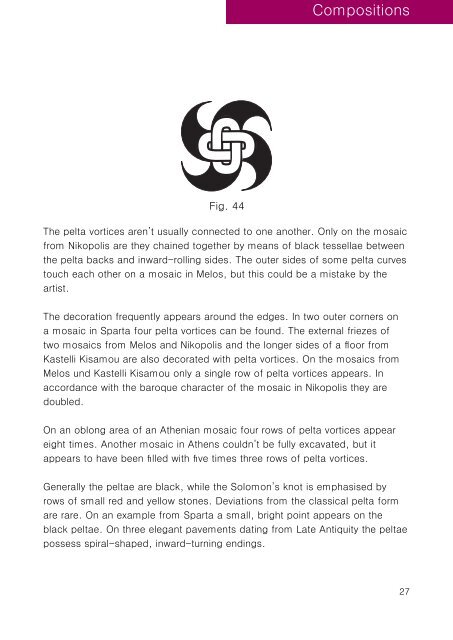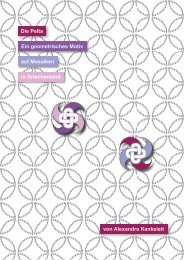The Pelta
A geometric motif on Roman mosaics in Greece
A geometric motif on Roman mosaics in Greece
Create successful ePaper yourself
Turn your PDF publications into a flip-book with our unique Google optimized e-Paper software.
Compositions<br />
Fig. 44<br />
<strong>The</strong> pelta vortices aren’t usually connected to one another. Only on the mosaic<br />
from Nikopolis are they chained together by means of black tessellae between<br />
the pelta backs and inward-rolling sides. <strong>The</strong> outer sides of some pelta curves<br />
touch each other on a mosaic in Melos, but this could be a mistake by the<br />
artist.<br />
<strong>The</strong> decoration frequently appears around the edges. In two outer corners on<br />
a mosaic in Sparta four pelta vortices can be found. <strong>The</strong> external friezes of<br />
two mosaics from Melos and Nikopolis and the longer sides of a floor from<br />
Kastelli Kisamou are also decorated with pelta vortices. On the mosaics from<br />
Melos und Kastelli Kisamou only a single row of pelta vortices appears. In<br />
accordance with the baroque character of the mosaic in Nikopolis they are<br />
doubled.<br />
On an oblong area of an Athenian mosaic four rows of pelta vortices appear<br />
eight times. Another mosaic in Athens couldn’t be fully excavated, but it<br />
appears to have been filled with five times three rows of pelta vortices.<br />
Generally the peltae are black, while the Solomon’s knot is emphasised by<br />
rows of small red and yellow stones. Deviations from the classical pelta form<br />
are rare. On an example from Sparta a small, bright point appears on the<br />
black peltae. On three elegant pavements dating from Late Antiquity the peltae<br />
possess spiral-shaped, inward-turning endings.<br />
27






